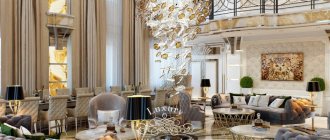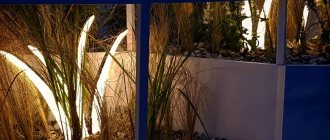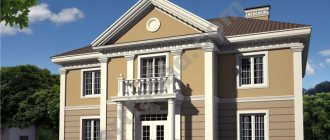Regular style
Classic or regular style creates a feeling of solidity, order and solemnity. This style implies clear lines and strict symmetry in the layout. The main elements of the concept are considered to be the presence of open space, ponds and fountains of predominantly rectangular shape, smooth parallel or perpendicular paths, and curly trimmed evergreen bushes.
The bush looks great in the center of the flower bed, especially if it is trimmed into a ball, cone or other unusual shape. Caring for a garden in a classic style is comprehensive. Constant trimming of shrubs and mowing the lawn is required to keep the garden looking beautiful. The classic style creates the feeling that nature has completely submitted to man, and the location of every pebble and flower is carefully thought out.
Colonial
The plot, decorated in a colonial style, is not only a place for relaxation, but also a source of fruit. Simple materials are used in its arrangement, and the placement of objects is based on the idea of practicality.
The main features of the colonial style:
- dividing the space into separate zones - agricultural buildings, an orchard and beds with vegetable crops;
- low white wooden fences defining the boundaries of each zone;
- narrow and straight garden paths covered with wooden decking or wood chips
- small figurines made of wood, stone or ceramics in the form of rabbits, ducks, angels;
- a terrace or veranda covered with hops and ivy;
- a compact fountain located near the veranda;
- forged arches and decorative gazebos;
- mobile flower beds in large flowerpots, tubs and urns;
- wooden and wicker furniture, rocking chair or hanging hammock;
- variegated flowers - daffodils, hyacinths, begonias, phlox, peonies, lilies, hydrangeas;
- the presence of medicinal and edible plants - lemongrass, marjoram, echinacea, saffron;
- variety of fruit trees.
High-tech style
This is the youngest of the landscape styles; it represents a set of design solutions that provide comfort and a minimum of garden maintenance. Modern garden style involves the use of materials such as concrete, metal, plastic, polycarbonate.
It is characterized by bright functional lighting, expressive lines, contrasting colors, and regular geometric shapes.
Asymmetry is allowed if it merges into a single picture. For lighting, façade illumination and solar-powered lamps are used. For landscaping, it is better to give preference to trees with an original crown shape and plants with rich colors.
For landscaping the site in a modern style, weeping birch, ornamental apple trees, blue spruce, barberry, and rhododendron are used. Abstract sculptures are suitable as decorative elements. As part of the modern style, ponds with a concrete or metal frame of the original shape are preferable.
Recommendations
A garden in a regular style, as you know, should have a large area. However, some elements of this type of landscape design can be used in small areas. For example, a regular style of the site can be achieved by creating flower beds decorated with trimmed shrubs. They do not require a large space, but bushes arranged symmetrically will influence the style of the garden.
If there is a gazebo on the site, then it is recommended to use forged metal or even wooden decorative carved elements in its design. Similar fragments would be appropriate for fences. A good option as an element of a regular style on the site would be a cast fence, executed in a classic, strict manner.
English style
The traditional English or landscape garden style has its roots in British culture. A site arranged in this manner is full of alluring charm.
The main task of the English style is to imitate the natural landscape. The style is characterized by asymmetry; the main features of this style are vertical gardening, a neat lawn, the absence of strict geometry, winding paths, benches made of natural materials, tall and shady trees.
A small pond with aquatic plants and a weeping willow is desirable. The style does not imply straight lines and outlines, figuratively trimmed trees and symmetrical paths. Its task is to preserve the naturalness of the plantings. Style dictates the selection of plants that grow well without direct sunlight. These are bright primroses, roses of different shades, violets, forget-me-nots, rosemary, verbena.
Regular style in landscape design: description
There are no small details in this direction. A regular style involves taking into account even the slightest nuances, which should very subtly harmonize with the overall image of the site. A clear layout is provided here. At the same time, you need to know that arranging a garden in a regular style is not as easy as it seems: such work requires a lot of effort and time, and caring for it is quite labor-intensive. However, the result completely pays for everything. A garden in a regular style, laid out on a country plot, will resemble a real park of French aristocrats. At the same time, every detail and image in it must be thought out to the smallest detail. A regular landscape style in a garden can be recognized by symmetrical plantings of shrubs and trees, regular geometric contours, straight alleys or paths, clear and measured compositions, complex parterres, pronounced center lines, as well as multifaceted water elements and numerous sculptures. All this gives the formal park orderliness and sophistication with notes of grandeur and solemnity. The French regular style is the complete opposite of the naturalness expected in an English or landscape garden.
Mediterranean style
The style reflects Mediterranean culture and combines elegant details with elements of nature. This style is inspired by Mediterranean landscapes.
For landscaping, citrus fruits, grapes, succulents, lavender, sage, and rosemary are used. The garden is decorated with gazebos covered with climbing plants.
All details work to enhance the relaxing atmosphere. Like Mediterranean cuisine, the garden style is also a mixture of Southern Italy and the dry regions of Spain. Integral details include gravel paths, terracotta pots, ceramic tiles and a comfortable seating area.
Small architectural forms in a regular style
In the French style, bulky and massive furniture is inappropriate. There are only two options for selecting household items - elegant, light products with elegant forged legs and supports, light seats, or typical furniture in the style of street cafes and summer terraces of restaurants.
But gazebos, if the area is large enough to install them, especially light structures in a romantic style, are welcome. In addition to those allocated in the basic structure, be sure to use each area in the garden, be it an extension, the intersection of paths or their “blind” end, for arranging zones and corners for relaxation.
A special place in the aristocratic French style should be given to potted gardens. If in the Mediterranean style they are simply displayed on platforms, then the French style is more inventive. He suggests using ladders or original multi-level supports for potted displays, which will simultaneously make the most of the space and emphasize the thematic design. Typical plants for the French potted garden are geraniums. A collection of different varieties on the steps of a staircase or even on a stepladder installed in a corner near the terrace is real French “chic”. For potted gardens, only white and pink flowering plants can be used.
Several potted plants should definitely be installed in the recreation area. They should be on the table, next to every piece of furniture, under seats and table tops. True, you should not use individual plants planted in pots, but entire potted compositions. What kind of flower pots will be is not so important, but light and non-glossy materials are better suited for the French style; in particular, clay vessels are considered typical. Roses, boxwoods, olive trees, laurel, citrus fruits, pomegranate, and lantana can be used as potted plants.
In such a garden, you simply must install at least one classic garden sculpture, reminiscent of French castles and palaces. If you have a high wall in your garden, then install a large mirror on it or create a wall landscape with perspective, camouflaging the sides with climbing plants. Such a spectacular “reflection” or unexpected perspective will bring a feeling of spaciousness and peace to the garden.
Dutch style
This style is directly correlated with the nature of Holland and its landscape. The Dutch were forced to conquer every piece of land from the sea, so their gardens are very small.
This style is associated with tulips, mills and canals. Essential features of the Dutch style are careful zoning.
In addition, ordinary trees are replaced with dwarf trees, perfect order is maintained on the territory, every square meter of the site is used to the maximum. Bright color accents, original garden figures and art objects are also used to decorate the garden.
Minimalist style
A garden in this style is laconic and expressive in its simplicity. This is perhaps one of the most complex styles, mainly because it uses a minimal number of components that can convey so much.
Minimalism does not tolerate pretentious textures of materials, color elements should not be bright and conspicuous, garden paths should be smooth with accentuated contours. When choosing plants, it is better to give preference to cypress, thuja, maple, and juniper. Flowers in ceramic or concrete containers of strict geometric shapes will fit organically.
Garden furniture should also be decorated in a minimalist style. This could be simple lightweight aluminum or plastic furniture.
Eco-garden style
Eco garden
Currently, eco-style in the garden is very popular. He recreates a corner of wild nature on the site. Such a garden is completely undemanding to care.
Basic elements of eco landscape style
- the presence of only natural materials in the garden
- combination of plants and stone
- a mixture of garden flowers and wild plants
- natural lawn of wildflowers
- forest plants
- intermittent paving, with grass or ground cover planted in between
- minimal interference with existing flora and natural landscape
Eco-garden color palette
Eco-style colors: natural colors.
Eco-style accessories
- rough garden furniture
- fire pit
- hut or simple canopy
- stumps, tree cuts, snags, log benches
- crafts from vines and branches
- plank or log bridges
- lamps in the treetops
Colonial Landscape Design
Colonial style dates back to the time when Europeans arrived in America and had to re-adapt not only to a new way of life, but also to a different climate. The style combines two different cultures: the colonialists and the aborigines.
The diversity of local flora and the multinationality of the colonialists led to a striking style, which is characterized by comfort and slight carelessness. Characteristic elements of a colonial garden: clear zoning, stone paving stones, sundials, fountains, symmetrical straight gravel paths between flowerbeds, a low white fence.
The obligatory gardening part of the site in the colonial style is an echo of how the first settlers, in addition to the decorative purpose, also attached practical significance to the garden.
Russian style of the 18th century
In landscape design, the Russian style is a mixture of features of other national styles borrowed from the cultures of Italy, England and France. Gradually, from this cocktail, seasoned with peasant and landowner traditions, a separate direction was formed, which has its own characteristic features.
Landscape design in Art Nouveau style
One of the most elegant styles originated in interior design. The Art Nouveau or Art Nouveau style that dominated the early 20th century had a strong influence on culture in general and also on the world of landscape design. Simplicity is the principle of designing a garden in a modern style.
The garden, designed in the Art Nouveau style, is devoid of decorations and adheres to strict symmetry. The pond is usually located in the center of the site. The paths are paved with tiles with geometric patterns or slabs of only two colors are used - black and white.
Accessories are allowed, but not in abundance. A minimum of plants and a limited number of small architectural forms are used. These are simple fences and black trellises on white walls.
No. 1. Classic style (regular, French)
The classic style of landscape design is strict symmetry , clear and geometrically correct shapes in the layout of the site, impeccably trimmed bushes and trees. There is no place for the naturalness of wild nature - demonstrative artificiality comes first.
Main features:
- straight alleys, strict forms of flower beds, trees and ponds. Fountains or other bodies of water are located in the center of the site or in the middle of some composition, gazebos are placed at the intersection of garden paths;
- suitable for large plots ( over 15 acres );
- Any colors can be used, but the shades should be soft. All natural materials are used, incl. stone and wood;
- preference is given to topiary plants . You can plant linden, globular thuja, pyramidal poplar, maple, pyramidal juniper, as well as maiden grapes, lilacs, spirea, and jasmine. Suitable flowers include roses, begonias, phlox and salvia. If you want to create an orchard on your site, it is better to plant trees in the form of an alley;
- gazebos should be round in shape, they can imitate an ancient Greek portico, you can use cast or wooden pergolas, forged benches. As decorations Antique sculptures, stone balls, classical columns, arches, Greek flowerpots with legs are suitable.
Scandinavian style
Scandinavian design is known all over the world and combines functionality with naturalness. The design is flexible and lively, without clear geometric shapes or bright accents. Despite its apparent simplicity, the style is phenomenally beautiful and takes the best from northern landscapes: Norwegian fjords, Finnish forests, Icelandic volcanic highlands.
A characteristic feature of the style is boulders and flat stones of equal size, stacked in the form of steps.
The concept of the Scandinavian style is also implemented by coniferous and dwarf trees, fruit and berry crops, ornamental cereals, paths paved with stones of various sizes, grottoes and stone arches, wooden sculptures, rattan garden furniture.
Country
The American continent is certainly considered the birthplace of this trend; the times of the exploration of the Wild West still remind us of themselves to this day. Wooden houses, garden fruit trees, a vegetable garden with a traditional wicker fence - all this is very familiar to the design of this style. In some features it is very similar to the previous one, rustic: there is still no lawn and natural grass, climbing plants on the extension to the house, trees and shrubs in wooden tubs, everything is quite natural and has no clear boundaries. Clay pots, wooden buckets or troughs serve as decoration.
Country style
Chinese style
Chinese style is based on the teachings of Feng Shui. When planning a site, the main feature should be the naturalness of the landscape, the balance of shapes and sizes.
Chinese gardens are a spiritual sanctuary, a place where there is a keen sense of connection with nature, as well as a world in miniature. The most important principle of the style is the harmonious combination of garden landscapes and architecture. The lines of the buildings follow the natural lines of the surrounding landscape. The accents of the Chinese style are stones and water, while plants play a secondary role.
Art Nouveau style (art nouveau)
Art Nouveau garden
Art Nouveau style is known for its streamlined shapes. This is an aesthetic and sophisticated style. As a rule, in an Art Nouveau garden, more attention is paid to small architectural forms and structure, rather than plants. Art Nouveau style, otherwise known as art nouveau, creates the impression of elegance and high cost. The peculiarity of this style are winding, smooth, arched lines.
Basic elements of a modern garden
- simplicity and smooth lines
- repetition of decorative elements (the pattern should be repeated in different design elements: in paths, plantings, ornaments on buildings, etc.)
- unity of style between home and garden
- a stream or a fountain, or the absence of a body of water
- many accents
- modern materials
Modern garden color palette
Art Nouveau colors: chocolate, black, red-brown, beige, dark gray, silver, pink, blue, purple, white. Contrast will be created by: yellow, red, fuchsia.
Garden accessories in Art Nouveau style
- large slabs, paving slabs, paving stones, garden parquet, natural and artificial stone are used for paving
- furniture and flower containers (made of concrete or terracotta) with strict outlines
- benches, gazebos, lanterns and fences should contain a forged base with a floral ornament characteristic of Art Nouveau
- figurines of birds, insects in bronze
Tuscan style
The roots of this landscape design come from the Tuscany region, located in southern Italy. This style recreates the atmosphere of the Old World.
The style combines rustic style with the elegance of the Italian Renaissance. The use of brick, forged elements, stone, and authentic Tuscan plants, including cypress, citrus fruits, olives, grapes, rosemary, and lavender, is encouraged. Natural yet refined materials create a relaxing atmosphere with a special charm. Bright details of the exterior - terracotta pots, a decorative pond with amphorae, elements of the ancient era.
Italian (Mediterranean) garden design style
Italian style is colorful and popular. For its implementation, subtropical vegetation is used. This landscape is ideal for the southern regions of Russia, where the climate is moderately mild and warm. The following nuances are considered to be the features of this direction:
- Successfully organized on relief terrain. The Mediterranean style of courtyard design looks good on slopes and uneven ground surfaces.
- Using plants with lush crowns, colorful and picturesque flowers. The predominant shades are blue, light blue, green, sand, orange, azure.
- Among the materials used to organize the exterior are: sand, natural stone, pebbles. If furniture is provided in the garden, it is made of artificial rattan and is complemented with decorative pillows in cases that match the color of the design.
- This style welcomes the cultivation of palm trees, citrus fruits and olive trees. Decorative spruce and juniper trees also look beautiful. They will dilute the colorful atmosphere with their shade. The crowns of these crops are carefully trimmed. If there are arches in the yard, they can be decorated with wild climbing grapes or one of the varieties of ivy.
- Additional decorations and accessories are required: forged elements, garden figures, benches, amphorae and other decorative objects. Metal and ceramics are a great combination in Italian landscape style.
On a note! Take care of arranging cascades, fountains and a small pool in the center of the yard. These objects are required in the selected landscape.
Landscaping in the Dutch style with many colors Source rehouz.info
Decorating the backyard with flower beds with bulbous perennials Source rehouz.info
Dutch design in the exterior of the local area Source build-experts.ru
Dutch exterior style near a private house Source domnomore.com
Backyard design in Dutch landscape style Source modernplace.ru
Japanese landscape design
The Japanese garden is characterized by restrained purity of style, compositional precision and asceticism. No details of the landscape should distract from the contemplation of natural harmony or immersion in one’s own thoughts. The manner is based on Buddhist and Taoist philosophy.
Japanese style strives to create miniature copies of nature itself. This practice is an art form in the Land of the Rising Sun. Elements of a Japanese garden imitate or symbolize natural elements. The delicate combination of stones, calm or running water, and plants creates a special world.
The stylistic features of the Japanese-style garden design are the asymmetrical layout of the site, paths paved with stones, a natural pond, sand decorated with wave-like patterns and symbolic compositions made of natural stone.
Plums, maples, pines, cherries, bamboo, pine trees, willows, peonies, chrysanthemums, and bonsai are used for landscaping. The view created in a Japanese garden is far from real nature, but is based on it. Japanese gardens are not meant for walking, but for contemplation. When creating a Japanese-style garden, a sense of proportion and taste is important.
History of creation
The described trend originated in France during the reign of Louis XIV. It was used to decorate the land in front of the palaces and castles of the king and nobles. They owned vast territories, for their landscaping, and a new principle was developed for creating parks that could emphasize the greatness of the owners and their material wealth. The gardens of Versailles were impressive in their scale. They evoked surprise and admiration. They took a long time to create, but the layout of the gardens was very practical.
Regular park of Versailles Source pinterest.com
At the very beginning of the creation of gardens in a regular style, at the laying stage, the main central alley was laid out. You could travel along it by carriage from the central gate and get to the square in front of the palace. The alley divided the territory into two equal parts. They were designed identically in compliance with the principle of strict symmetry.
Later, this concept became increasingly more complex: axes and vectors were created within each part, which further emphasized the symmetry of the plant arrangement. In this way, the gardeners emphasized the man-made nature of the park. They had a goal: the gardens were to be part of the palace ensembles; they were to emphasize the splendor and monumentality of their architecture. The end result should demonstrate the unlimited power of man over nature. Such a creation will make an impression only if the ideal order in the creation of landscaping is elevated to the rank of the dominant dominant.
Corner of a regular park Source pinterest.co.uk
An open space was always left in front of the palace. It was called porter. On its territory, flower beds and flower beds were created, ponds were laid out, and fountains were built. Today, such parks are no longer created: their maintenance is too costly and labor-intensive. But individual elements are actively used to decorate their own personal plots.
On our website you can get acquainted with the most popular plots in the Moscow region for the construction of a country house. In the filters you can set the desired direction, distance from the Moscow Ring Road, cost per hundred square meters, size, availability of infrastructure, gas, water, electricity and other communications.
Moorish style
The garden in this style is closed from prying eyes. This is the rightful heir to the Hanging Gardens of Babylon. Hidden behind high walls, this exotic oasis is filled with oriental luxury, bright colors, sweet aromas, lush greenery and fountain water sparkling in the sun.
The Moorish garden amazes with its pristine beauty; it seems to invite you to enjoy life and continuous pleasures. The geometric regularity of the landscape is combined with a large amount of vegetation. The paths are lined with ceramic tiles, the exterior decoration is fruit trees and roses with a thick, exciting aroma.
The center of the garden is a pond or fountain. The presence of a patio is a charming feature of the Moorish garden. Other important elements of this concept include wrought iron elements, wall fountains made of mosaic tiles, benches and tables covered with mosaic tiles.
Characteristics and features of a regular garden
Axial compositions are very popular. They are usually formed around a central axis - an alley, a path. Often in the center of the axis there is a water feature - a pond or fountain. On both sides of the central axis, symmetrical compositions are formed - lawns and flower beds of regular shape, alleys and alleys with bushes and trees with trimmed crowns.
An example of an axial composition on a small area. On both sides of the central path there are geometrically regular symmetrical lawns on which plants are planted in rows; the trees on the site are located in a special symmetry, forming an interesting combination
Bosquet is an integral part of a regular park. A bosquet is a group of shrubs or trees planted in a specific way. Plants trimmed in a special way can form something like a green gazebo or room, a curtain that hides visitors from prying eyes, imitate various geometric shapes or even some architectural forms - arches, columns, turrets.
There are two types of bosquets:
- the so-called office, where plants are planted around the perimeter;
- An artificial grove is a group of ornamental shrubs or trees that are planted on the lawn:
An example of an office in a regular park - trimmed bushes form a green wall, in the niches of which there are arches and statues. In the center of the office there is a symmetrical composition in the form of a flower bed. In your garden, you can also make a similar curtain of shrubs and lawn, forming a cozy corner
A small artificial grove, to create which you can also use ornamental plants in tubs
A regular garden is unthinkable without neat, regular-shaped lawns; they largely give such a garden a ceremonial and noble appearance.
The history of gardening art goes back hundreds of years; already in the 16th century, gardeners created magnificent regular gardens and parks surrounding the imperial palaces. In many ways, this style has remained unsurpassed, and today it surprises with its clarity, elegance, luxury and nobility of lines.
Of course, it is not possible to create a real regular park in a relatively small area, but you can use some characteristic elements - symmetrical planting of plants on geometrically regular lawns located along the central alley, or several paths diverging in straight lines from a pond or flower bed.
Recent Entries
7 flowers that are planted in September to admire the primroses in early spring We begin to prepare indoor plants for winter: a work plan for September 4 simple ways to determine the quality of the soil without purchased tests
Two examples of the formation of a composition around a central path: 1) using an arch and symmetrically located bushes; 2) using a central flowerbed and a gravel path framing it
You can plant flowers in flower beds in such a way that they form ridges. A rabatka is an elongated rectangular flower garden, where various flowers are planted in a certain order, forming beautiful patterns. This flower bed will look great on the sides or between garden paths.
Flowers planted in a special way form beautiful patterns on flower beds and lawns, making them look like a colorful carpet
The regular style of the garden also involves the use of sculptures or sculptural decorations in the antique style. For example, if the central alley in your garden is quite wide and long, it will be decorated with two statues located at the beginning of the alley opposite each other. You can use vases on pedestals, or one large vase in the middle of the central flower bed.
Classical sculptures are a decoration of a regular park; they complement the composition and look picturesque against the backdrop of luxurious greenery
And also, in a classic regular park there is always a top point from where you can see the ground floor - lawns, flower beds, trees planted in a certain order. This garden is especially beautiful from above. In a private house, such a point may be a balcony.
We invite you to watch an interesting video on the topic:
Provence style
The Provence style garden is simple and cozy. The conceptual features of this stylistic direction are reminiscent of antiquity. Aged wood is used for garden furniture.
To decorate the site, wicker arches, paved paths with overgrown plants, stone wells, terracotta pots with planted lavender, wrought iron benches, gazebos entwined with roses or grapes, and an open terrace filled with flower pots are used.
For landscaping, drought-resistant shrubs and herbs, peach trees, cypresses and olives are used.
Country landscape style (rustic)
Country style garden
The rustic or country style can be considered the most ancient of all landscape design styles, because human society began to develop from small settlements, modest houses with simple lawns of wildflowers and fruit plants.
Basic elements of country style
- lush flower beds of wild plants
- natural lawns
- small natural style pond
- paths made of tree bark, gravel or tree cuts
- hand-made products
- combining fruit and flower crops into one composition
- orchard and vegetable garden
Rustic color palette
Country style colors: white, yellow, red, all bright colors.
Country style accessories
- wooden fence or wattle fence
- benches and wells
- pergolas made of timber or logs
- wooden barrels
- rustic pots or cast iron pots
- birdhouses, houses and bird feeders
- small architectural forms in the form of domestic animals and poultry made of natural materials (wood, clay, stone)
Eco style
This style implies complete unity with nature. The basis of the concept is the choice of plants that do not need frequent watering. It is preferable to choose local flora for landscaping the site.
Decorating a garden in an eco-style is preferred by people who care about the environment and treat nature with care for the sake of future generations. Even if there is no goal to arrange a garden with fewer natural resources, an eco-garden will help save money and minimize maintenance of the local area. The landscape is being transformed in such a way as not to disturb the miniature ecosystem and to preserve large trees.
The landscape design examples above are just a few of the more popular styles. In the process of choosing from a variety of artistic techniques for decorating an open area, one should take into account the features of the area, the architectural style of the house, and the size of the plot. But the main thing is not to forget that a garden is a reflection of the soul of its owner. Then the site will become a source of pride, and caring for it will bring pleasure.
dizlandshafta
Landscape style of landscape design
In order for the landscape style in landscape design to fit harmoniously into the yard and turn out complete, this will require up to 12-14 acres of space. This design is suitable for flat and hilly areas. The main distinctive characteristics of the landscape style are:
- Smooth, sophisticated lines. No sharp changes in the design of shrubs and decorative flowering perennials. Soft forms are welcome: winding paths, asymmetrical banks of reservoirs.
- The use of natural materials for decoration in landscape style. For this, only wood and natural stone are used. Forged lamps will look good near paths and near ponds.
- It is not recommended to plant exotic flowers and other plants: shrubs, perennials. Only those that grow in your area are welcome. Focus on established ornamental grasses and natural turf.
- To organize the design, use calm shades of the palette. Pale pink, blue, green, purple will do. Bright unnatural tones: orange, light green, poisonous yellow will only spoil the appearance. Therefore, avoid plants with this color.
- Free growth of vegetation is encouraged. Shrubs and trees do not require constant maintenance of the same shape.
To make the entire created garden look luxurious and natural, small clearings are specially landscaped on a landscape-style site and planted with small-leaved field herbs.
Landscape design with a pond Source pinterest.ru
Floral landscape style of landscape design Source dizainvfoto.ru
Mixed landscape design in the local area Source yandex.ru











